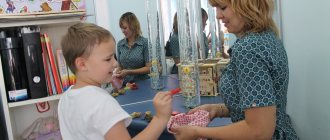Article:
A child’s speech at 1 year of age depends on how the preparatory work for its development was carried out from birth to one year.
Humming, babbling and pronouncing the first words prepared the articulatory apparatus for more complex work; the baby's acquaintance with the objects of his immediate environment enriched his passive vocabulary. At the age of one year, the baby already knows the meanings of many words, the active dictionary contains 10–25 words, and he begins to use speech as a means of communication. He can pronounce words correctly (mama, lalya, baba), babble (pa, ma, bah), partially reproduce the forms of words (“kach” - swing, “zya” - impossible), and imitate the voices of animals and the sounds around him (mu -mu, boo-boo, pee-pee, beep).
At this stage, it is already possible to determine whether there are speech problems. Unlike specialists, it can be difficult for parents to see them, but below we will tell you what signs you can use to independently identify speech problems in your baby.
Passive and active vocabulary
During this period, attention is drawn to such a characteristic feature as imitation of the words of adults. The baby repeats not only familiar words, but also previously unknown ones. These could be words addressed to the child, or words that he heard from others. Such active imitation can be noticed already from 1 year 5 months. Here it is important not to coo with children, faking your speech in “childish” language, but to give an example of the correct pronunciation of words.
Starting from the first year of life, the understanding of words grows; the baby is familiar with the names of objects in his immediate environment, the names of objects, animals and other objects that are most often shown to him in pictures in children's books, on the street. The baby loves to look at bright colored book illustrations. Adults should maintain this interest by choosing clear pictures.
When commenting on illustrations to a child, you need to speak precisely, in simple words, try to denote the object with one, constant word, so that the meaning of the picture is not lost in the stream of speech of an adult. For example, while the word monkey is used to describe monkeys and gorilla.
By the age of one and a half years, a child’s active vocabulary is 20–30 words; its sound composition is still simple. Thanks to the desire to imitate the speech of adults, by the end of the second year the baby increases the number of spoken words tenfold. Speech is dominated by nouns, but there are also verbs (2-3 times less of them) and adverbs (there, here, here).
Occasionally, by the age of two, the use of adjectives can be found in children's speech; this feature will continue to persist into early preschool age. Personal pronouns are often found in a child’s speech and are easily used (I, you, he, she).
Defects caused by hearing problems
Even a slight decrease in hearing acuity negatively affects articulation. If a small child has hearing loss, speech development is impossible. Children who were born deaf and lost their hearing before the age of 3 will remain mute without special training. At the same time, the speech apparatus is not damaged, and intelligence is within normal limits.
Decreased or absent hearing is not related to mental abilities. Many children can attend regular schools. But for this you need to contact a speech therapist as early as possible and begin correction.
Grammatical structure of speech and sound pronunciation
After one and a half years, the ability to change words in the simplest ways appears, linking them into one phrase (give me a doll - “give me a ku”). Monosyllabic sentences are most often used. In such primitive sentences, one word can be used in different meanings. By pronouncing the word “mu,” in one case the child wants to be given a toy, and in another, with the same word, he draws the adult’s attention to the eyes or horns of the toy cow that he is holding in his hands.
By the end of the second year of life, sentences may contain three or four words. Sentences can be both interrogative and exclamatory. The question words themselves are not yet available to the child; he expresses the question by the intonation with which he pronounces such a sentence. There are no prepositions in the words yet either (“Seva bi-bi” - Seva has a typewriter).
All vowel sounds are already pronounced by the baby in the second year of life. Its articulations and some consonant sounds are available: m, p, k, t, d, n, f, x, b, g, v, y. The clarity of their pronunciation depends on the place of the sound in the word and the number of syllables in it. In simple words of one or two syllables, all sounds are pronounced correctly (Katya, dad, Tanya, Vova). These same sounds are “swallowed” and distorted in more complex words (pisina - machine). Combinations of two consonant sounds next to each other (heb - bread) are also difficult for the baby, especially if these are sounds that are difficult to pronounce, for example: s, sh, r, l.
Different rates of speech acquisition by children of the same age become noticeable. This depends on the individual characteristics of the baby, heredity, and diseases suffered in early childhood. Of great importance is the intensity of communication between adults and the child, how the child’s speech development is stimulated at 1 year of age.
Prognosis and prevention
If your baby was talking and then suddenly fell silent, then don’t despair. In most cases, the prognosis is very favorable. Timely correction allows you to eradicate the pathology. The exception is cases when the baby has stopped speaking words due to severe damage to the central nervous system or Landau-Kleffner syndrome.
To prevent a child from becoming silent, parents must pay special attention to his emotional state. At the first signs of stress, it is better to contact a psychologist. The child should be surrounded with care and helped to develop his speech. However, no preventive measures have been created to prevent aphasia. The only thing parents can do for their child is to undergo timely medical examinations, prevent traumatic brain injuries and severe neuroinfections.
Norms of speech development in the second year of a baby’s life
Assessing a child’s speech at one year of age is very problematic: the guidelines for its development are very arbitrary and a delay in speech activity is acceptable. You can give approximate norms at the end of the second year of life:
- the baby answers simple questions;
- he can carry out a simple order, for example, take a cup to his grandmother, give him an item or a toy;
- the child easily repeats simple phrases and simple words after adults;
- all vowels and most consonants are available to its pronunciation;
- by the age of one and a half years, the baby combines two words into a sentence, and by two years, he constructs a sentence of 3–4 words;
- he actively and on his own initiative enters into communication with other children and familiar adults;
- he can ask a question using intonation;
- the child is able to pronounce at least 50 words, more often 200–300;
- begins to use singular and plural nouns (cube - cubes), diminutive suffixes (house - house);
- he can understand and follow two-step instructions: “Take the spoon on the table and take it to dad”;
- the baby can show two or three parts of the body or more;
- listens to nursery rhymes, fairy tales, poems, tries to remember small pieces.
If in the list above you see an item that your baby does not meet, it is worth closely observing the child, assessing whether he strives to communicate with others, whether he understands speech addressed to him. It is possible that the baby has a slight delay in speech development.
Incorrect articulation
This group includes dyslalia, or tongue-tiedness, and dysarthria. Dyslalia manifests itself in the fact that the baby does not pronounce all the syllables of a word or replaces them with others. It is divided into mechanical and functional. In the first case, articulation problems arise due to improper development of the mouth or nasopharynx. This disorder is comorbid - it is accompanied by nasality, slowing or accelerating the rate of pronunciation. Functional impairment is associated with a weakening of nerve impulses transmitted by brain structures.
For children 2-3 years of age, the pronunciation of the first or last syllables of a word is considered a conditional norm. In speech therapy there is even a concept of “physiological dyslalia.” If the problem persists longer, consultation with a speech therapist is necessary.
Dysarthria or slurred speech may also be accompanied by the pronunciation of parts of a word. This pathology develops against the background of injury or inflammation in the structures of the brain, when systemic blood flow is disrupted. In this case, coordination of movements is impaired, swallowing is difficult, and involuntary salivation is possible. The range of movements of the articulatory apparatus is limited. The voice becomes quiet or disappears completely. The child pronounces words slowly, making uneven intervals.
Symptoms of delayed speech development in a baby
How to understand that a one-year-old child has a delay in speech development? This question interests many parents, and often moms and dads rush from one extreme to another. Some, seeing how their child’s peers express themselves fluently and freely, anxiously listen to the speech of their child, who has not mastered even half of this vocabulary. Others, relying on the stories of those who tell how their silent children suddenly spoke at 3, 5, 6 years old, do nothing and wait for the same miracle, and then face the problem of a serious delay in the development of their baby.
The age from one to two years is a kind of milestone when it becomes clear whether a child’s speech is developing normally, or whether the child has one of the following pathologies:
- motor alalia
- sensory alalia,
- dysarthria,
- aphasia,
- rhinolalia,
- hearing loss, or lack of hearing,
- delayed speech development,
- general speech underdevelopment.
At two years old, it is necessary to have your baby examined by a specialist if he has the following symptoms:
- the child is silent or babbles in one language he understands;
- when asked what his name is, he turns away;
- the baby does not turn to an adult when he needs something, but hums or points with his finger;
- the child understands what is said to him, but cannot formulate the statement himself;
- at first speech appeared, there were words or even phrases in it, and then it disappeared, and the child practically fell silent;
- by 2 years of age there are almost no words in speech.
Based on the results of the examination, at two years of age it is advisable to begin stimulating speech development, and parents themselves can make significant progress in this direction. Many simply do not know what and how to do, so it is recommended to go for a consultation with a speech therapist, psychologist or defectologist - you can work with them from the age of 2.
What is general speech underdevelopment (GSD) in children?
General speech underdevelopment (GSD) is a violation of the development of speech skills in a child. Most often, it can be detected at the age of three, when the child begins to actively talk. But OHP is not a symptom of a serious illness, but most often simply insufficient attention of parents to the child’s speech. For example, if a child says “yba”, “suba”, “dau”, and the parents do not correct him, thinking that “it will go away on its own”.
⠀
Four months ago, one of the social networks of the Kidskey online school received the following message:
⠀
“My son is 4 years old. He has been going to kindergarten since he was 3 years old, but he hardly speaks. His speech is similar to the babble of a one-year-old child. I understand it only when it is explained by gestures. My friends reassure me that boys start talking later, but I am very worried because in the kindergarten the children do not want to play with my son, he constantly cries, gets angry and even offends his classmates.
⠀
I do not know what to do. Please tell me, should I do something now or should I wait until the child outgrows it? Is it necessary to go to a specialist or can you practice speech development at home?”
⠀
It is difficult to give some abstract advice without talking to the child. That's why we invited the mother and boy for a free online consultation.
⠀
Wonderful and smiling Roma had no problems with hearing or intelligence, but he communicated with our methodologist like this:
⠀
- instead of “give” he said “yes-yes”, instead of “there is” he said “us-us”;
- instead of a whole word, he named only the root and used it to designate several words at once - “ma” - “machine”, “ba” - “drum”, “banana”, “battery”;
- he spoke the same words in different ways: “machine” - “asha”, “bibi”, “pipi”, “si”;
- I shortened complex words and phrases: “mom went to work” - “ma sya a atu.”
⠀
After the consultation, it became clear that Roma has general speech underdevelopment (GSD) of the first degree.
Speech therapists can make this diagnosis to a child if he said his first words only after 3 years or if he explains himself more with gestures. For example, instead of saying “Mom, give me some candy,” he says “give me,” and then points his finger at the cabinet where the sweets are.
⠀
Below is a table with the norms for child speech development by age . Take a look, but don’t get too hung up on this data - each child is individual and develops at his own speed.
Self-diagnosis of speech delay
Without being specialists, parents are unlikely to be able to independently determine the cause of the speech defect. They only have access to simple diagnostics. Parents can determine:
- Is the baby's hearing impaired?
- What is the state of the child’s gross and fine motor skills?
- whether the mobility of his articulation organs is preserved,
- to what extent he understands the speech addressed to him.
Hearing test
Hearing impairment is a significant cause of delayed speech development. Without hearing the correct pronunciation of words, the baby will not be able to pronounce them. You can suspect such a pathology if the following symptoms appear over the course of a year:
- the baby does not respond to quiet sounds that are heard outside his field of vision;
- it does not turn towards the source of the sound;
- the child does not show interest in music, the sounds of operating household appliances, electronics;
- the baby does not understand when he is addressed;
- he does not imitate onomatopoeia, there is no babble or simple words in his speech;
- the child does not use his voice to attract the attention of adults.
If you have doubts, you can check your baby’s hearing yourself. To do this, you need an adult assistant and a separate room, protected from extraneous noise. The baby should be invited to play with sounding toys with his mother. Next, the adult uses them to make sounds behind the baby’s back at a distance of at least 6 meters, so that he does not see the source of the noise. If there is no reaction, the distance is reduced by one meter, getting closer to the child with each stage.
You can start the examination by whispering behind the baby’s back, depicting an unusual combination of sounds that should attract the child’s attention. Then these sounds or the baby’s name are repeated in a voice at normal volume. The same procedure is carried out a few days later. If you suspect absence or decreased hearing, you should show the child to an otolaryngologist.
Diagnostics of fine and gross motor skills
It is not for nothing that such great importance is attached to the examination of motor skills. The areas of the brain responsible for the development of speech and fine motor skills of the child are located next to each other. There are no problems with fine motor skills, which means that the mechanisms of speech emergence are preserved, and, most likely, the problem does not lie in the field of neuropathology. Uncertain and uncoordinated movements, inability to make precise movements with the hand and fingers - you need a consultation with a neurologist and a thorough diagnosis.
Indicators of the development of general motor skills by the end of the child’s second year of life:
- He can run;
- climbs stairs well, stepping on each step in turn with one foot;
- jumps up low or jumps over a very low obstacle;
- kicks the ball;
- steps over objects;
- marches, although not too deftly;
- may back away.
Achievements in the development of fine motor skills in a two-year-old child:
- tries to stop the ball rolling towards him;
- he can stack from 4 to 6 cubes on top of each other (“building a tower”);
- the child draws vertical lines or simply “doodles,” although he often holds the pencil or felt-tip pen incorrectly;
- he has a well-developed “tweezer grip,” when the baby takes very small parts of toys or pieces of food with two fingers;
- he strings the rings of the pyramid onto the pin of the stand;
- tears small pieces from a sheet of paper or a piece of plasticine.
To determine the level of development of motor skills, there is no need to organize a special examination; it is enough to carefully observe the child’s movements while awake.
Diagnostics of articulation organs
Anomalies in the structure of the speech organs and impaired mobility can affect the ability to pronounce certain groups of sounds. To detect pathology, it is enough to check the structure of the tongue, jaws, lips, and palate.
Possible problems:
- progeny - the lower jaw is pushed far forward relative to the upper jaw;
- prognathia – the upper jaw protrudes forward;
- open bite - a gap is visible between the closed teeth;
- high and narrow palate (“Gothic”);
- shortened frenulum of the tongue, it is difficult for the baby to lift the tongue upward, it begins to bifurcate in the child like a snake;
- massive or very small tongue.
In addition to these defects, parents may notice increased salivation, tongue trembling, limp lips, and a constantly slightly open mouth. If you have such symptoms, you should immediately contact a specialist. Failure to carry out timely corrective measures can lead to the development of mental retardation and even mental retardation.
Testing speech understanding
To make sure that the child understands the speech addressed to him, he is asked to complete several tasks in a playful way:
- offer to choose one toy from several laid out in front of the baby;
- understands and selects red, yellow, blue and green objects;
- assemble a matryoshka or pyramid
- ask to show things that he uses in everyday life: a spoon, a cup, a chair, slippers;
- offer to show yourself or the doll body parts;
- ask to find an object or action in the picture (they can be cut out from unnecessary magazines and pasted on cardboard);
- offer to fulfill a simple request: bring a book, come closer, give a toy.
The absence of defects in the organs of articulation and understanding of the speech of others with underdevelopment of speech skills may indicate a tempo delay in speech or general underdevelopment of speech. Stimulating classes with a specialist, started as early as possible, will help overcome the gap with peers.
Speech disorders
Incorrect articulation can be considered normal in children under 2-3 years of age. If speech defects are persistent, speech therapy intervention is required. In case of pronounced pronunciation disorders, the presence of a severe speech disorder should be excluded.
Parents should not make a diagnosis on their own, but it is important to know about the most common pronunciation disorders in order to seek help from a speech pathologist in time and quickly cope with the disorder. If the defect becomes persistent, it will be more difficult to eliminate it. In speech therapy, it is customary to classify speech disorders into 4 types:
- incorrect articulation;
- pathologies of rhythm and tempo of pronunciation;
- defects caused by hearing problems;
- GSD (general speech underdevelopment) or loss of existing skills.
How to help a child talk?
First of all, show your baby to a pediatrician, otolaryngologist and neurologist to rule out physiological causes of lack of speech. If there are problems, begin treatment immediately. The more time is lost, the more difficult the path to recovery will be.
If the doctors have concluded that the child is completely healthy, then you need to create a favorable environment around him for the development of speech. How to do it?
Talk to your baby.
Children learn to speak by imitating adults. Some parents believe that the baby does not understand their speech, which means it is useless to talk to him. But that's not true. The child absorbs every word. Therefore, try to talk kindly to your baby while he is awake, and it is important that he clearly sees how your lips move when articulating sounds.
Talk to your baby correctly.
Pronounce sounds clearly and speak slowly so that the child has time to isolate individual words from speech. Comment on your actions, name and describe the objects you pick up, try to use ordinary words mixed with onomatopoeic words (such as am-am, bo-bo) and simple syntactic structures, but do not lisp or distort the sound appearance of the word. Speak as if you are expecting an answer from your baby.
Read, listen, sing
While your child is awake, play audio recordings of children's songs. Before bedtime, read fairy tales aloud to your child. Sing simple songs and nursery rhymes with him, recite short poems and nursery rhymes. All this enriches the child’s vocabulary and helps him master the grammar of his native language.
Ten to twelve months is the ideal time to introduce your baby to a book. Just choose “shockproof” editions with pages made of thick cardboard or textiles and large, bright pictures. Give your child the opportunity to play with the book, leaf through it, and look at the illustrations. When reading books, try to interest your listener, ask questions like “Where are the bunny’s ears? Where’s the nose?” etc. Special albums for speech development will be especially useful for your classes.
Put away the TV, gadgets and talking toys
All kinds of educational cartoons, tablet games and interactive toys, no matter how cool and expensive they are, only distract the child from what is happening around him. Give your baby the opportunity to explore the world around him independently. Give him the simplest “silent” toys - blocks, pyramids, textile animals and dolls. Let your child become the creator of the game, rather than a passive observer pushing a button.








